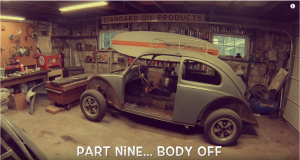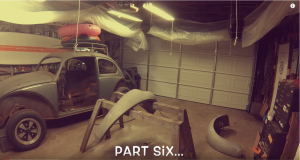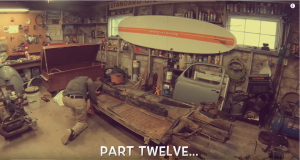Tools Needed:
Not many tools are needed for this step, but bring your patience. It takes a few basic things, but can get very frustrating if trying to disassemble the doors in the wrong order – when I was working on my 67 I found that out the hard way. Disassembling the doors in the right order is no problem – but you may run into stripped screws like I did which we’ll need to fix later. So here’s all you need:
- Screwdrivers – get a couple different size flat head and phillips head screwdrivers – the flat head screwdrivers will be used mostly for prying window trim and getting to hard to reach places, and the phillips head will be for unscrewing the fasteners holding all the door parts. IMPORTANT: If you are taking the doors off the car, do yourself a huge favor and get a #4 phillips head screwdriver with an end that you can get a wrench on, OR a bit that will fit in your rattle gun or impact wrench. They also make hammer (impact) screwdrivers that can be useful if the door screws aren’t cooperating. Just make sure to have the right size bit and save yourself a lot of trouble… even with the right bit you might strip one of the door screws (like I did – and I’ll need to fix later when I put it back together)
- Socket Wrenches – a basic metric socket set will do for this – nothing special, just a few different size bolts to undo
Removing and disassembling the doors:
I’m removing the doors, but this isn’t necessary if you’re only trying to replace the windows or door parts – I’ll explain the process including my worse case scenario where I stripped a couple of the door to body screws.. ugh.
Removing the doors:
So, in a perfect world, removing the doors would be easy – using a #4 phillips screwdriver bit on a rattle gun/impact wrench is ideal, and the doors will slide right out of the slots in the body. But if the doors have never been removed, it’s not likely that they’ll come off easily. They’ve either been painted over, or are so comfortable where they’ve been for 50 years, that they don’t want to move. In my case, they were painted and comfortable. The painted over screws adds an extra layer of stuck-ness. If you’re able to get the screws out without them stripping then lucky you! If you end up stripping some screws, here’s a couple options to get them out:
If one of the door screws strips, stop! Don’t try to keep digging at it and cause more of a mess. Just decide how you want to remove it since a screwdriver won’t work. I tried all of these tricks, but in the end had to resort to drilling out the screws – which causes the headache of needing to re-tap the door plates before I can put the doors back on (I’ll get to that in a later video).
Welding a bolt to the screw – this is a good trick and may be nice to know for other applications, but especially tricky with these door screws because they’re inset in the body and hard to reach with a welder. I’ve read a lot of other people having success with it, but I wasn’t so lucky. Here’s the idea though – take a good size (12mm or so) bolt and weld the bolt to the top of the screw head (where it’s stripped).
If you’re able to get a good weld onto the screw head, you can use a wrench on the bolt and unscrew the bolt (which is attached to the screw) and voila! The bolt will unscrew the screw easy as that.
I was able to get a strong weld on the screw, but even so, the bolt would not budge and eventually snapped. I’m sure if I were a professional welder, it would’ve worked fine, but I’m not so had to figure out another way.
Screw extractor – these are a waste of time from my experience (at least when trying to extract seized metal on metal bolts/screws). They might work when trying to extract a screw or bolt from a wooden plank, but not from metal to metal that won’t budge with a wrench in the first place. I’ve tried more than once over the years and every time it fails. You can try though – I did, I tried again, but just added to my frustration.
Drilling the screw out – yep, this is where I ended up. The screws on the door are flared at the ends, so I started with about a 1/4″ drill bit, right in the center of the screw. I drilled down until I was drilling into the shaft of the screw, then went a little bigger with the drill bit size – once I drilled far enough with the drill bit bigger than the screw shaft itself, the top of the flared screw popped off and I was left with the shaft of the screw still in the door plate (where it attaches to the body). I’ll need to drill this out later and re-tap for the door installation, but this was enough to get the doors off.
Doors off and ready to disassemble inner door:
With the doors off, I was able to put the up on the sawhorses to make it a little easier to reach all the parts and have gravity work with me instead of against me. You can disassemble the doors while they’re on the car of course, but as I said before, do it in the right order. Rather than re-invent the wheel and explain it step by step, it would be better just to point to some videos that show the process from the beginning to the end – on the car or off the car, it’s the same. Chris Vallone shows the process in this two part video here.
Broken door hinge:
In my case, I had a couple extra steps. First of all, the driver’s side bottom door hinge had been bent badly before I owned the car. With the doors off, I could see that the metal where the door hinges are welded to the door had torn, causing a problem where the door hinge would flex when moving it back and forth by hand. This had to be fixed – so I used some channel locks to grab the door hinge and pry it back into the correct position – aligning it with the top hinge and test fitting on the car, back and forth until the door closed smoothly without stress on the hinge. I then used the welder and my handy dandy welding wooden stick to push the area where the metal had torn, and welded that tear in the metal back together. Hit it with the grinding wheel, and good as new – after the body work, it won’t be noticeable.
Stripped wing window screws:
Another little problem I ran into was that the screws at the top of the wing window were rusted and wouldn’t budge – they were rusted and weak and the heads stripped with barely any pressure. So I had to drill them out, but that’s not a big deal because they’re just small sheet metal screws that won’t require re-tapping when I’m ready to put the windows back together. However, they were a little annoying because when I tried to drill them, the spun and I wasn’t able to get any grab with the drill. I used a flat head screwdriver to brace the screw in place and keep the it from spinning while I drilled.
Now that the doors are all stripped down, I can do the body work without worrying about breaking windows or dealing with the extra weight and hassle – I just have the door metal to get ready for paint which we’ll start later. To finish the day, I went back to doing some rough body work on the fenders/hood/engine lid – small steps to roughly get the panels in shape before getting to the finer body work – which I’ll also get to in later videos.



